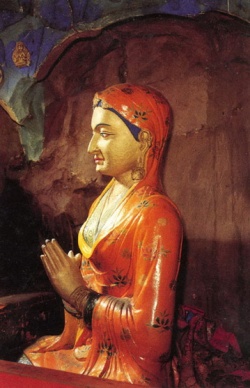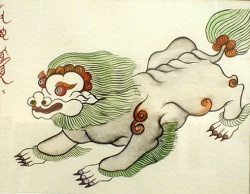Three Inner Tantras (nang rgyud sde gsum) Mahayoga, Anu Yoga, and Ati Yoga
These three sections of tantra are the special characteristics of the Nyingma School of the Early Translations. According to Jamgon Kongtrul the First, “The Three Inner Tantras are also known as the ‘Vehicles of the Methods of Mastery’ because they establish the way to experience that the world and beings are the nature of mind manifest as kayas and wisdoms, that everything is the ‘indivisibility of the superior two truths,’ and hereby ensuring that the practitioner will become adept in the method of gaining mastery over all phenomena as being great equality.” The Three Inner Tantras are, respectively, also renowned as ‘development, completion, and great perfection’ or as ‘tantras, scriptures, and instructions.’
According to Mipham Rinpoche, the Three Inner Tantras reached Tibet through six different lines of transmission:
1) As perceived by ordinary people in Tibet, Padmakara, the Second Buddha, taught only the Instruction on the Garland of Views but bestowed both the profound and extensive empowerments and instructions of all of the Three Inner Tantras to his exceptional disciples including Sangye Yeshe, Rinchen Chok, Lui Wangpo of Khon, and many others, the oral lineages of which have continued unbroken until this very day. Moreover, the major part of his teachings were sealed as terma treasures for the benefit of followers in future generations.
2) When the great translator Vairotsana extensively had received the profound teachings of the Great Perfection from the Twenty-five Panditas, especially from Shri Singha, he returned to Tibet and imparted the Mind Section five times, as well as the oral lineage of the Space Section, Vimalamitra both of which are continued uninterruptedly.
3) The great pandita Vimalamitra arrived in Tibet and taught the Instruction Section chiefly to Tingdzin Sangpo of Nyang. This lineage was transmitted both orally and through terma treasures.
4) Sangye Yeshe of Nub received from four masters in India, Nepal and Drusha innumerable teachings headed by the important scriptures of Anu Yoga and Yamantaka. His lineage of the Scripture of the Embodiment of the Realization of All Buddhas is still unbroken.
5) Namkhai Nyingpo received the transmission of the teachings of Vishuddha from the Indian master Hungkara which he then spread in Tibet.
6) During following generations, incarnations of the king and the close disciples of Padmasambhava have, and still continue to do so, successively appeared, as great masters who at opportune times reveal the profound teachings that had been concealed as terma treasures, in order to ensure the supreme welfare of people in Tibet and all other countries, both temporarily and ultimately.

